Dijon: A Gastronomic Guide
With the advent of the new Cité Internationale de la Gastronomie et du Vin, Dijon is putting itself firmly on the gastrotourism menu. Alexander Lobrano enjoys a taster…
Perhaps the most surprising thing about Dijon, a very handsome historic city of 160,000 in eastern France, is that this fascinating and charming town has been relatively overlooked by the thousands of vinophiles who come each year to visit the great winemaking villages and vineyards of Burgundy. It’s a place, I discovered within a few hours, where one could easily spend a week savouring its stunning architecture; visiting its churches, monuments and museums; sipping its wines; browsing its excellent food and wine shops; and dining in its many superb restaurants.
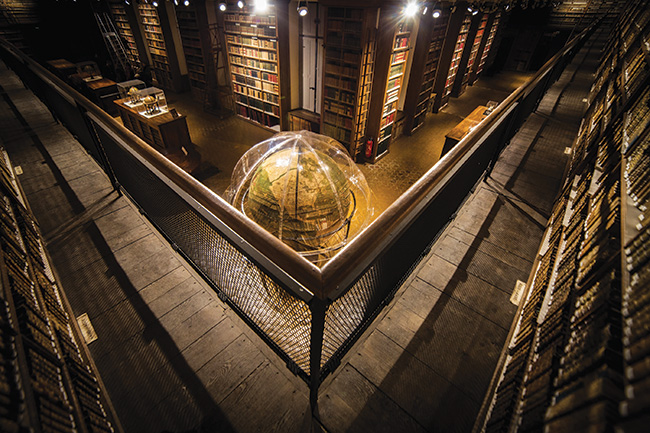
The Bibliothèque Municipale of Dijon © Anne Sophie Cambeur Le Studio Des Songes
Gourmet Pedigree
The capital of Burgundy, Dijon has one of the most distinguished gastronomic pedigrees of any place in the world. Among many other distinctions, it gave its name to one of the world’s most popular condiments, the eponymous mustard. Mustard has been produced in the city according to strict rules since they were first prescribed by a decree issued on August 10, 1390, when Dijon moutardier Jean Naigeon replaced the usual vinegar in the recipe with verjus, the acidic juice of unripe grapes, creating what became known as Dijon.
As well as a superb covered market, Dijon and Burgundy have 30 Michelin-starred restaurants and, just as importantly, many Bib Gourmand (the label given to good value restaurants with outstanding food) restaurants, resulting in one of the densest concentrations of gastronomic excellence anywhere in the world.
The Bibliothèque Municipale of Dijon, the city’s public library, is housed in the Collège des Godrans, a magnificent hotel particulier which became a Jesuit college in 1581. It’s home to Le Fonds Gourmand, one of the richest collections of books and other publications, in French and other languages, on gastronomy and wine. The library has received substantial contributions of gastronomically-themed books from the Bibliothèque Nationale in Paris, and also has one of the largest collections of French-language menus in the world, with more than 16,000 menus beginning with one from 1810 and continuing through to contemporary menus. The books may be consulted in the magnificent reading room of the library, and regular exhibitions put the menus on display with different themes. “We take them for granted, but menus are actually intriguing and very revealing artefacts of living history,” says Caroline Poulain, assistant director of the library and curator of its gastronomic collections.
Dijon also has one of the richest art museums in the French provinces, the recently renovated Musée des Beaux-Arts, which opened in 1787 in the vast and elegant 15th-century Palace of the Dukes and States of Burgundy. Highlights of its rich collection range from intricately carved medieval triptychs to paintings by Delacroix, Pissarro and Manet.
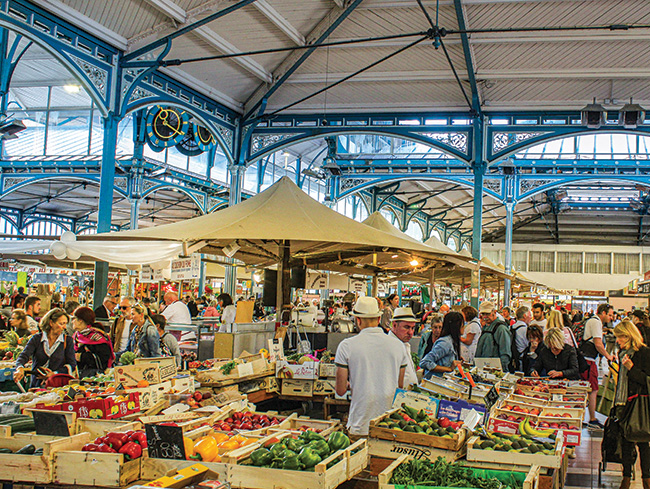
Wander around Les Halles to see some wonderful local produce © Shutterstock
Centre for Gastronomy
The slightly under-the-radar status of Dijon is set to change, however. Opened in May, the new Cité Internationale de la Gastronomie et du Vin is a striking complex of modern buildings and beautifully renovated former hospital buildings dating back to the 15th century on a 13-acre site on the southwestern edge of the city. The project, which took ten years to complete, cost an eye-popping €250m.
A hard-hat preview of the Cité with Jérémie Penquer, the director of the project, was the grand finale of my visit to Dijon. This fascinating new institution, which includes a branch of the prestigious Parisian cooking school L’École Ferrandi, a wine bar serving over 300 wines by the glass, and several restaurants, should actually be the first stop of any visit to Burgundy because it offers an essential background education in the region’s gastronomic and viticultural history, along with fascinating exhibitions devoted to Les Climats du Vignoble de Bourgogne and Le Repas Gastronomique des Français, both of which are UNESCO-listed.
Les Climats are precisely described and delineated individual vineyards in Burgundy between Dijon and Santenay which were recognised by UNESCO in 2015. The importance of Les Climats is the spectacular quality of the wine they produce, including Chambertin, Romanée-Conti, Clos de Vougeot, Montrachet, Corton and Musigny.

The restaurant at the Grand Hôtel La Cloche @ Office de Tourisme de Dijon
The Repas Gastronomique des Français refers to the history of celebrating good food and wine in France and celebrating important moments in life with a special shared meal that begins with an aperitif, continues with four or five courses and concludes with a digestif. The success of these meals depends upon the skills of choosing the finest seasonal produce, designing a menu of courses that has a gastronomic logic and elegance, setting an attractive table and animating the conversation among one’s guests. “The repas is an essential element of France’s identity, which we have perhaps taken too much for granted in the past. This is why it was so important when it was recognised by UNESCO in 2010,” says Jérémie Penquer.
Dijon is one of four Cités de la gastronomie, a cultural initiative launched by the French government in 2013 created to showcase the country’s gastronomic heritage. Each city has a different mission: Dijon’s is wine and the two UNESCO listings; Lyon’s is nutrition and health; Tours focuses on human and social sciences as they relate to food, with the creation of a new university devoted to the cultures of food in France and elsewhere; and Paris’ is the marketing of food, with its HQ at Rungis, the largest wholesale food market in the world. These new cultural facilities will promote the skills, métiers and savoir-faire of the culinary world as well as increase the availability of vocational training, encouraging research and innovation and stimulating an appreciation of great food.
The International Organisation of Vine and Wine is planning to move its headquarters from Paris to Dijon in August, which will further bolster the city’s already impressive credentials as an international capital of gastronomy, viticulture and agro-industrial research and innovation. Beyond all of the grand projects in Dijon, it’s a city where the love of great food and wine is everywhere. Waiting for the tram in front of the train station when I’d arrived on a drizzly morning, I laughed when it arrived, since I was almost certain that its cyclamen under-carriage was intended as a reference to another of Burgundy’s most famous products, crème de cassis, the blackcurrant liqueur used in a Kir cocktail, the popular aperitif made with either white or sparkling wine.
The old woman who had been waiting next to me at the tram stop, grinned and nodded at me after we’d sat down beside each other in the tram. “I saw that you immediately understand our little joke,” she said. “You must have visited Burgundy before,” she added.
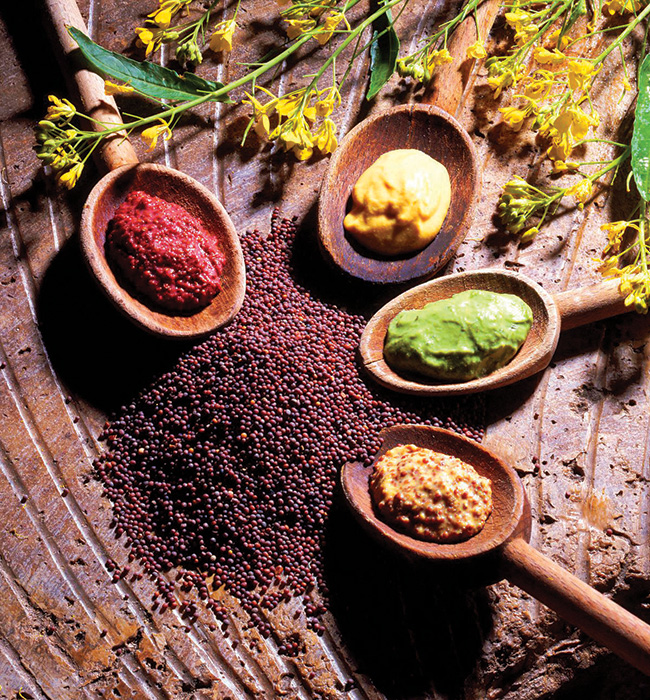
Dijon is famous for its mustard © La Moutarderie Fallot
I nodded, although I hadn’t been to Dijon for a while, which is why I was so impressed by how the city had changed. I confided in her that I’d always liked a nice kir made with white Bourgogne Aligoté wine, and she replied that I’d come at an opportune moment because Dijon has recently seen the opening of some excellent new restaurants run by talented young chefs.
“In the past, the ambitious ones all went to Paris and stayed, but I think they come home now after they’ve done their training because Dijon is such a pleasant place to live.” She then uncapped her fountain pen and jotted down the names of several restaurants: L’Aspérule; Cibo – a talented young chef; L’Évidence – another talented young chef; La Maison des Cariatides. “There are many more, of course, but I’ll let you discover those on your next visit to Dijon. Vous-voyez, monsieur, Dijon est une ville a se délecter tout doucement. Ici il faut prendre son temps,” (Dijon is a city to be enjoyed slowly. Here you must take your time).
In other cities, this conversation would have struck me as remarkable, but in Dijon it registered as charming, natural and totemic of Burgundian hospitality and joie de vivre. Best of all, as it turned out, I was actually on my way to one of the restaurants this lovely lady had recommended: Cibo, which I review in this very issue. Suffice to say, I had a spectacular meal there.
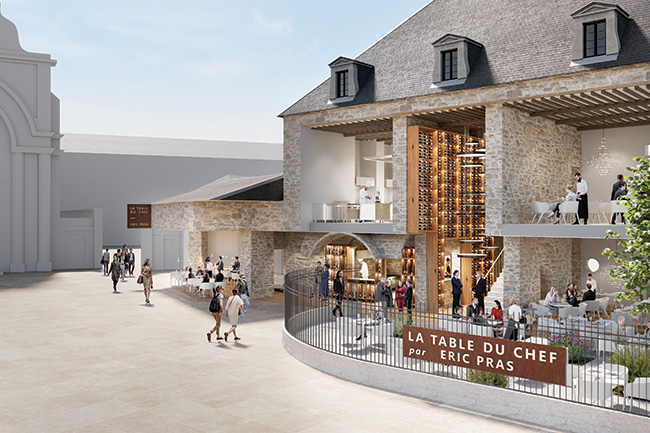
La Cité internationale de la gastronomie et du vin © Epicure
If a deep love of food and wine is profoundly woven into the warp and woof of France, in Burgundy, it is the region’s warp and woof, and the reasons for this date back deep into its history. Winemaking began in and around Dijon when it was the site of an important Roman fortress called Divio on the highway from Lyon to Mainz, and began to thrive, like the city itself, during the Middle Ages as the craft was perfected and refined by Catholic monks. When Robert, Duke of Burgundy chose the site for his capital in 1015, Dijon blossomed into one of the wealthiest and most refined cities in Europe. The Dukes of Burgundy, whose Duchy extended all the way to the Netherlands and included most of Luxembourg and much of Northern France at the height of its power, were renowned all over Europe for setting a sumptuous table, including local delicacies like snails and gingerbread, along with the finest wines.
When the Duchy of Burgundy was first annexed by France in 1477 and then permanently incorporated into France in 1678 under the Treaties of Nijmegen, its gastronomic know-how was absorbed into the canon of French cuisine at the court of King Louis XIV.
While some medium-sized French cities have struggled to retain their small shops and other independent merchants due to competition from national chain stores in suburban mall settings, Dijon is not only a delightfully lively, pedestrian-friendly city, but a commercially thriving one as well.
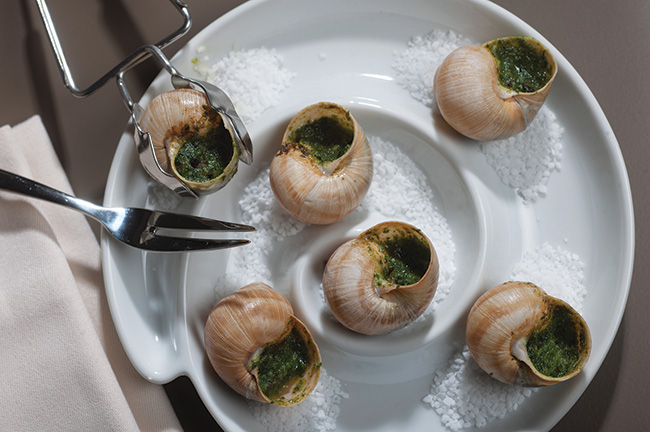
Escargots © Office de Tourisme de Dijon, Michel Joly
I’ll admit it might seem rather gourmand, but after lunch at Cibo, it was a pleasure to stroll around the heart of Dijon visiting some of its best-known and most beautiful boutiques for various Burgundian comestibles. Needless to say, the city is an excellent place to stock up on fine quality mustard, so I ducked into the boutique of Edmond Fallot in front of the beautiful cathedral of Notre-Dame for pots of stone-ground mustard flavoured with yuzu (Japanese citrus), which is excellent in vinaigrettes, and the green peppercorn mustard that goes so well with cold meats, especially ham, and then treated myself to a personal red-glazed clay Burgundian-made mustard pot with my name etched into it by a laser machine at the nearby Maille boutique.
Both Fallot and Maille regularly introduce limited-edition mustards, like the excellent Scotch whisky-spiked Maille mustard which, I discovered, went so well with game. Next, I headed to the beautiful neo-Renaissance-style boutique of Mulot & Petitjean, a renowned Dijon-based producer of pain d’épices, a dense and delicious local delicacy made in Burgundy since the Middle Ages, where the shop assistant told me that many Dijonnais like to start their days with a slice of toasted pain d’épices with salted butter, a rather perfect sounding breakfast indeed.
Warming to my theme, I picked up some pain d’épices-flavoured macarons from pâtissier Fabrice Gillotte’s shop and then finally ducked into Le Chalet Comtois, an excellent cheese shop, for an alluringly odorific Époisses, one of Burgundy’s signature cheeses, from Gaugry, a producer in the village of Brochon, who is one of the last two fromagers to produce this tangy orange-tinted cheese using raw milk from Burgundian cows (the other producer is GAEC des Marronniers). I also selected a wedge of one of my favourite cheeses, the washed-rind Cîteaux, which is made by monks at the Abbaye Notre-Dame de Cîteaux, 15km south of Dijon.
My afternoon concluded with a brilliant wine-and-cheese tasting by wine merchant Hadika Simon at her shop La Source des Vins. The most interesting takeaway from a flight of five wines and paired cheeses was the startling excellence of the Bourgogne Aligoté, a white made from the Aligoté grape, which accompanied an aged Comté cheese. Hadikau chuckled when I told her how surprised I was by this wine. “Most people react that way,” she said. “Because Aligoté was traditionally a rustic and very acidic wine, which is why it was used to make kirs. The crème de cassis softened and masked the acidity of the wine. Now, though, a young generation of French winemakers have been rehabilitating it with better vinification and barrel ageing for up to 18 months. This brings out the aromatic nose of this long under-rated cépage, along with its minerality and refreshing citrus notes.”
One last blast of indulgence rounded off this blissfully gastronomic day in Dijon as I concluded my tour with an exceptionally good meal at the one-Michelin-starred Loiseau des Ducs. The spiced yellow with wilted cabbage and mustard chlorophyll from mustard maker Fallot was a succulent and very original example of contemporary Burgundian cooking. Should you be hankering after a good boeuf bourguignon, however, head for La Fine Heure, where it’s authentic and delicious.

Gevrey-Chambertin @ Office de Tourisme de Dijon
A Return Visit is on the Menu
The following day, I quickly ducked out to Les Halles de Dijon, the city’s food market which occupies several beautiful 19th-century glass-and-wrought iron pavilions, to shop for a picnic. My main destination was Charcuteries Marcel Sabatier, because I’ve had a relentlessly insatiable craving for his jambon persille (shredded ham in parsley aspic) ever since I first sampled it at the house of a friend in Beaune 20 years ago. A wedge of Cîteaux cheese, a fresh baguette and several apples rounded out the al fresco feast I’d planned partly to make the most of this fine spring day but also to remain on the right side of any possible breathalyser during an impending day of wine tasting.
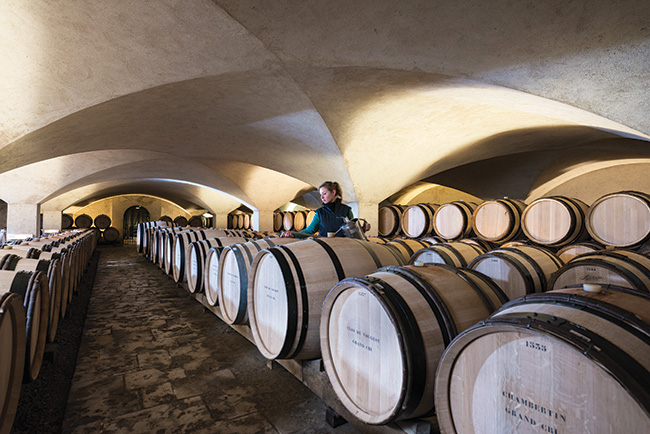
Château de Marsannay’s cellars © Michel Joly
Leaving Dijon behind, our first stop was the Château de Marsannay, the first château of the Hautes-Côtes de Nuits, which is one of the three most prestigious wine regions of Burgundy. The château owns 28 hectares of the best climats, or vineyard parcels, in the Marsannay appellation, a rising region, and its wines are stored in barrels in vaulted cellars built in the Cistercian style.
During a tasting of an exquisite flight of wines, including a 2017 Marsannay Les Favières, a 2016 Clos de Vougeot Grand Cru and an intriguing white Marsannay, we learned that at the impetus of its mayor, Dijon has been buying up land on its outskirts with the idea of planting vineyards that could some day make the largest city in Burgundy the first stop on any wine-lover’s pilgrimage to the region. Although this interesting news certainly gives us something to look forward to, we’ll definitely be coming back to this delicious city long before the first vintage of any Côtes de Dijon is bottled, because it’s the sort of delectable destination one eagerly returns to again and again. And that’s worth raising a glass to.
Where to Stay and Eat in Dijon
Eat
L’Aspérule
43 Rue Jean Jacques Rousseau, Dijon
Tel. (33) 03 80 19 12 84
Lunch menus €42, €90; dinner menus €90, €110.
www.restaurant-asperule.fr
Cibo
24 rue Jeannin, Dijon
Tel. (33) 03 80 28 80 76.
Average à la carte €70.
www.cibo.restaurant
L’Évidence
53 Rue Jeannin, Dijon
Tel. (33) 03 80 67 69 37
Menu du marché €23, €27; prix-fixe menus €34, €39, €49; average à la carte €45.
www.restaurant-levidence-dijon.com
La Fine Heure
34 rue Berbisey, Dijon
Tel. (33) 03 80 58 83 47
Prix-fixe menus €31, €34, €36, €39; average à la carte €40.
www.lafineheure.fr
Loiseau des Ducs
3 rue Vauban, Dijon
Tel. (33) 03 80 30 28 09
Prix-fixe lunch menu €28: prix-fixe menu €51, €75, €95; average à la carte menu €85.
www.bernard-loiseau.com
La Maison des Cariatides
28 Rue Chaudronnerie, Dijon
Tel. (33) 03 80 45 59 25
Average €40.
Stay
The Grand Hôtel La Cloche has long reigned as Dijon’s best address but a new Hilton will open at La Cité internationale de la Gastronomie et du Vin in 2023, and Mama Shelter hotel will also be opening its doors in Dijon some time next year.
Grand Hôtel La Cloche
14 place Darcy, Dijon
Tel. (33) 03 80 30 12 32
www.hotel-lacloche.com
Shop
Le Chalet Comtois
28 rue Musette, Dijon
Tél. (33) 03 80 30 48 61
Fabrice Gillotte
21 rue du Bourg, Dijon
Tél. (33) 03 80 30 38 88
www.fabrice-gillotte.fr
Maille Dijon
32 Rue de la Liberté, Dijon
Tel. (33) 03 80 30 41 02
www.maille.com
Moutarderie Fallot
16a rue de la Chouette, Dijon
Tel. (33) 09 54 04 12 62
www.fallot.com
Pain d’Épices
Mulot & Petitjean 13 place Bossuet, Dijon
Tel. (33) 03 80 30 22 45
www.mulotpetitjean.fr
Contacts
Dijon Tourist Office
en.destinationdijon.com
La Cité internationale de la gastronomie et du vin
www.citedelagastronomie-dijon.fr
From France Today magazine
Lead photo credit : The vast and elegant 15th-century Palace of the Dukes and States of Burgundy in the heart of Dijon @ Shutterstock
Share to: Facebook Twitter LinkedIn Email
More in best places to eat in Dijon, Burgundy, Dijon, food review, French food, french gastronomy
Leave a reply
Your email address will not be published. Required fields are marked *






REPLY